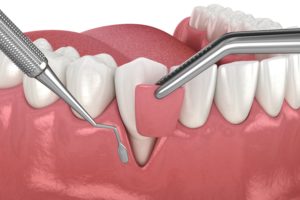
Our oral health is just as dependent on our gums as our teeth because they play a major role in keeping our pearly whites safe and secure. Sometimes gum disease results in a receding gumline which can damage teeth if left unaddressed. Our gums don’t grow back naturally, so it’s important to call your dentist if you’ve found yourself in this circumstance. They can bulk up your gums with a procedure called gum grafting. If your dentist has recommended this treatment and you don’t know what to expect, keep reading to learn more about what it is and how it works.
Why Do I Need A Gum Graft?
A receding gum line is usually due to underlying gum disease. Debris from the food we eat can attract unhealthy germs that stick to our teeth and form plaque. Sometimes, they penetrate our gums and flourish, resulting in infection. Our gums pull away from our teeth to avoid this, which is called “receding”.
Without our gums, the vulnerable roots of our teeth become exposed to harmful bacteria and infection. These dangerous microbes can work their way through your tooth and all the way into your jawbone. Over time, if your gums pull back too far, the teeth no longer have sufficient support and there’s a real risk of tooth loss. Nobody wants that!
What Is A Gum Graft?
Thankfully, your dentist can address your receding gumline with a gum graft. During this surgical procedure, they will carefully place tissue from inside your mouth (often the roof of the mouth or inside of your cheek) over the areas where the gums have pulled away from your teeth.
In most cases, your dentist will use a local anesthetic, so you don’t experience any discomfort during the process. If you’re anxious, they may recommend sedation so that you can remain relaxed and calm throughout your visit.
After Treatment Care
You’ll be given specific instructions for how to best care for your mouth following your gum graft. You can expect to:
- Avoid brushing or flossing the surgical site until it has healed.
- Rinse with a special solution that will keep bacteria at bay.
- Take any prescribed medications, like antibiotics.
- Eat soft, cool foods like eggs, Jell-O, yogurt, cottage cheese, well-cooked vegetables, and pasta.
- Manage symptoms like slight swelling or aching with over-the-counter pain medications like ibuprofen or Tylenol.
Once your gums heal, it’s important to keep up healthy oral hygiene habits so you don’t have a repeat occurrence. You should brush and floss your teeth twice daily to keep your gums clear of food particles and bacteria. Also, be sure to keep up with regular dental visits like cleanings and checkups. It’s the best way to catch any issues and treat them early before they cause further harm.
Your entire mouth suffers when you have gum disease. If you do have an issue that results in a receding gumline, it’s usually treatable with a gum graft that will keep your teeth safe and secure. Once it’s completed, you’ll have a healthier smile with no one the wiser!
About the Author
Dr. John C. Tunnell earned his Doctorate in Dental Surgery from The University of Texas Health Science Center at San Antonio before completing his residency at The Texas A&M University Baylor College of Dentistry. He’s a board-certified periodontist, meaning that he’s an expert in gum health. If you have receding gums and would like an appointment, you can request one on the website or call (469) 640-6730.
